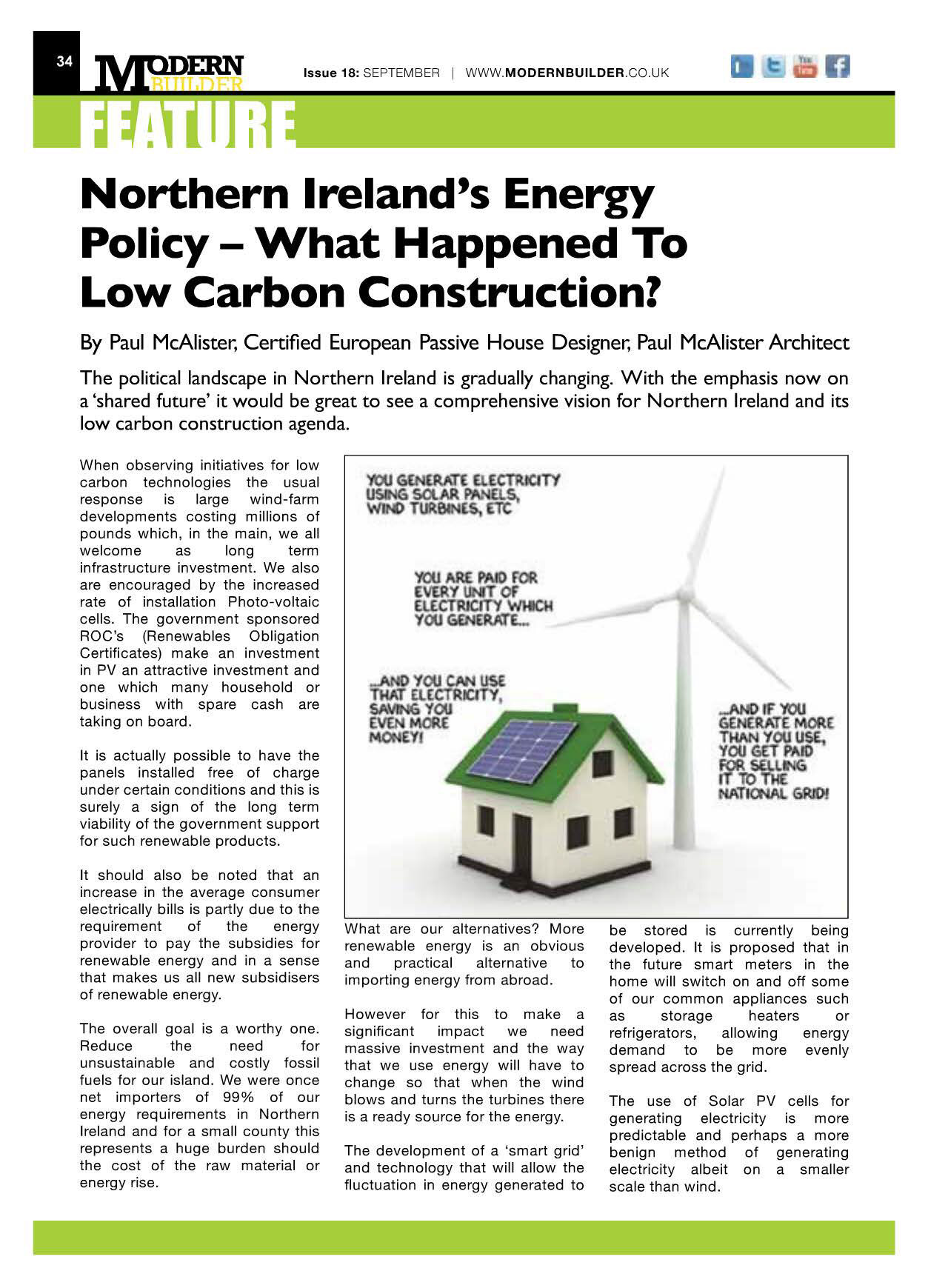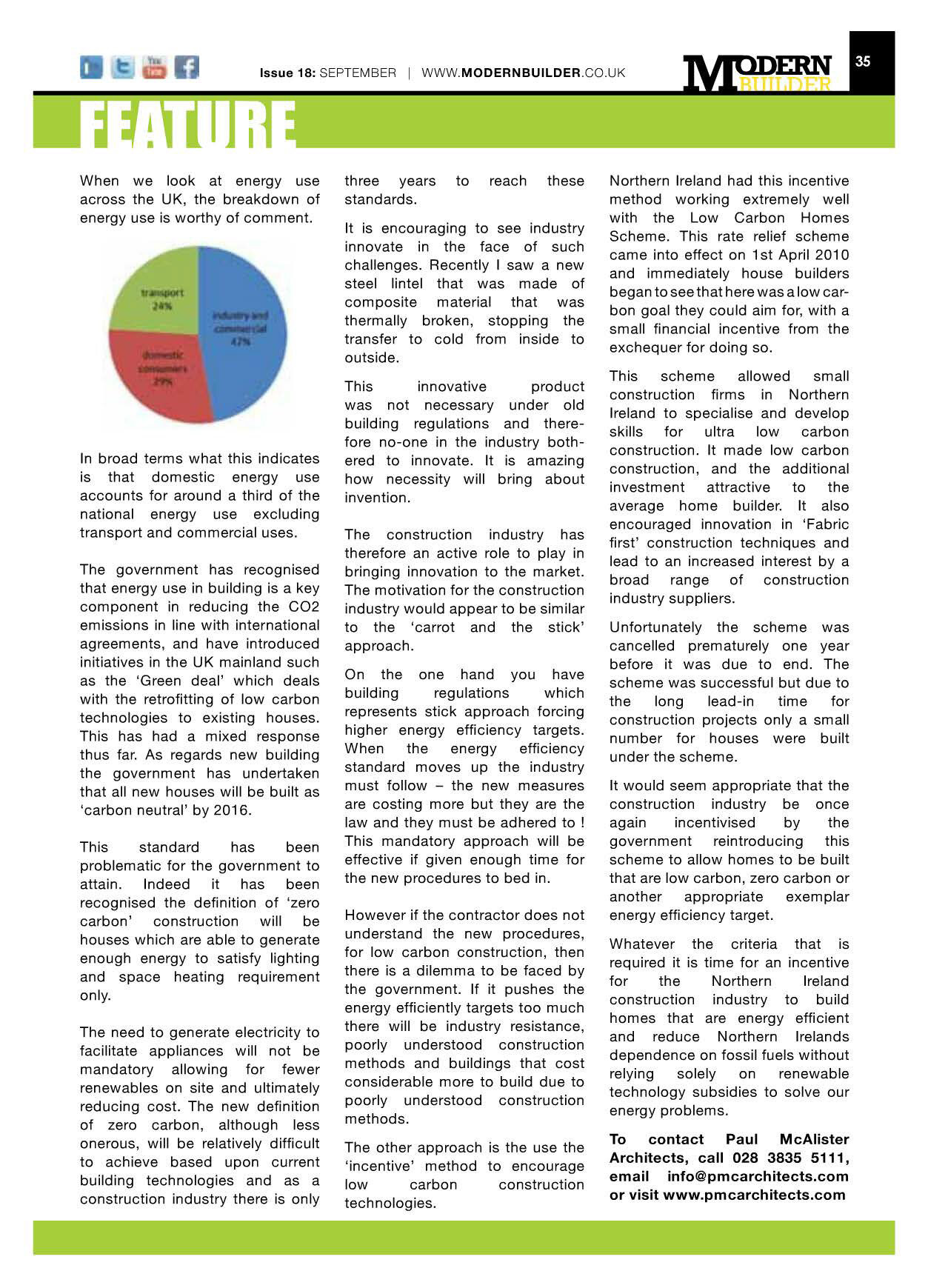Modern Builder - September 2013



When observing initiatives for low carbon technologies the usual response is large wind-farm developments costing millions of pounds which, in the main, we all welcome as long term
infrastructure investment. We also are encouraged by the increased rate of installation Photo-voltaic cells. The government sponsored ROC's (Renewables Obligation Certificates) make an investment in PV an attractive investment and one which many household or business with spare cash are taking on board.
It is actually possible to have the panels installed free of charge under certain conditions and this is surely a sign of the long term viability of the government support for such renewable products.
It should also be noted that an increase in the average consumer electrically bills is partly due to the requirement of the energy provider to pay the subsidies for renewable energy and in a sense that makes us all new subsidisers of renewable energy.
The overall goal is a worthy one. Reduce the need for unsustainable and costly fossil
fuels for our island. We were once net importers of 99% of our energy requirements in Northern Ireland and for a small county this represents a huge burden should the cost of the raw material or energy rise.What are our alternatives? More renewable energy is an obvious and practical alternative to importing energy from abroad.
However for this to make a significant impact we need massive investment and the way
that we use energy will have to change so that when the wind blows and turns the turbines there is a ready source for the energy.
The development of a 'smart grid' and technology that will allow the fluctuation in energy generated to be stored is currently being developed. It is proposed that in the future smart meters in the home will switch on and off some of our common appliances such as storage heaters or refrigerators, allowing energy demand to be more evenly spread across the grid.
The use of Solar PV cells for generating electricity is more predictable and perhaps a more
benign method of generating electricity albeit on a smaller scale than wind. When we look at energy use across the UK, the breakdown of energy use is worthy of comment. In broad terms what this indicates is that domestic energy use accounts for around a third of the national energy use excluding transport and commercial uses.The government has recognised that energy use in building is a key component in reducing the C02 emissions in line with international agreements, and have introduced initiatives in the UK mainland such as the 'Green deal' which deals with the retrofitting of low carbon technologies to existing houses.
This has had a mixed response thus far. As regards new building the government has undertaken
that all new houses will be built as 'carbon neutral ' by 2016. This standard has been
problematic for the government to attain. Indeed it has been recognised the definition of 'zero
carbon' construction will be houses which are able to generate enough energy to satisfy lighting
and space heating requirement only.
The need to generate electricity to facilitate appliances will not be mandatory allowing for fewer renewable on site and ultimately reducing cost. The new definition of zero carbon, although less onerous, will be relatively difficult to achieve based upon current
building technologies and as a construction industry there is only three years to reach these
standards. It is encouraging to see industry innovate in the face of such challenges. Recently I saw a new steel lintel that was made of composite material that was thermally broken, stopping the transfer to cold from inside to outside.This innovative product was not necessary under old building regulations and therefore no-one in the industry bothered to innovate. It is amazing how necessity will bring about invention.
The construction industry has therefore an active role to play in bringing innovation to the market. The motivation for the construction industry would appear to be similar to the 'carrot and the stick' approach. On the one hand you have building regulations which
represents stick approach forcing higher energy efficiency targets. When the energy efficiency
standard moves up the industry must follow - the new measures are costing more but they are the law and they must be adhered to! This mandatory approach will be effective if given enough time for the new procedures to bed in. However if the contractor does not understand the new procedures, for low carbon construction, then there is a dilemma to be faced by the government. If it pushes the energy efficiently targets too much there will be industry resistance, poorly understood construction methods and buildings that cost considerable more to build due to poorly understood construction methods.
The other approach is the use the 'incentive' method to encourage low carbon construction technologies. Northern Ireland had this incentive method working extremely well with the Low Carbon Homes Scheme. This rate relief scheme came into effect on 1st April 2010 immediately house builders began to see that here was a low carbon goal they could aim for, with a
small financial incentive from the exchequer for doing so. This scheme allowed small
construction firms in Northern Ireland to specialise and develop skills for ultra low carbon
construction. It made low carbon construction, and the additional investment attractive to the average home builder. It also encouraged innovation in 'Fabric first' construction techniques and
lead to an increased interest by a broad range of construction industry suppliers.
Unfortunately the scheme was cancelled prematurely one year before it was due to end . The
scheme was successful but due to the long lead-in time for construction projects only a small
number for houses were built under the scheme.
It would seem appropriate that the construction industry be once again incentive's by the government reintroducing this scheme to allow homes to be built that are low carbon, zero carbon or another appropriate exemplar energy efficiency target. Whatever the criteria that is required it is time for an incentive for the Northern Ireland construction industry to build
homes that are energy efficient and reduce Northern lrelands dependence on fossil fuels without relying solely on renewable technology subsidies to solve our energy problems.
